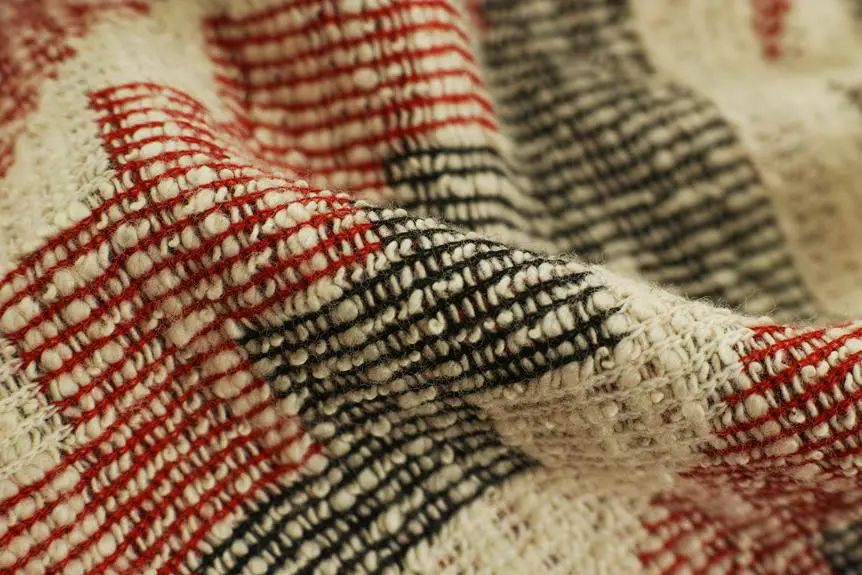As you consider the environmental impact of your clothing choices, you might wonder: can poly tricot, a synthetic fabric commonly used in activewear and outdoor gear, be recycled? The answer isn't straightforward. While poly tricot's production process is complex and its recycling isn't yet widespread, researchers and innovators are actively exploring ways to break down and reuse this material. Current methods do exist, but they're not without their limitations. You're likely curious to know what's being done to improve poly tricot recycling – and what this might mean for the future of sustainable fashion.
Table of Contents
What Is Poly Tricot Fabric
Poly tricot is a type of synthetic fabric made from polyester. You'll often find it used in clothing, especially activewear, lingerie, and swimwear, due to its stretchy and breathable properties.
Poly tricot fabric is woven in a way that creates a soft, smooth texture and a subtle sheen.
When you touch poly tricot fabric, you'll notice it's lightweight and has a bit of give. This is because it's woven with a specific type of weave that allows for a small amount of stretch.
This makes it comfortable against your skin and allows for a full range of motion. Unlike cotton or linen, poly tricot is quick-drying and resistant to wrinkles, making it a low-maintenance choice for many people.
Additionally, poly tricot fabric can be easily dyed and printed, which is why you often see vibrant colors and fun patterns on clothing made from this fabric.
Poly Tricot Recycling Challenges
Several challenges hinder the recycling of poly tricot fabric, making it difficult for you to dispose of your old poly tricot clothes in an environmentally friendly way. One of the main challenges is the lack of standardization in poly tricot production, which makes it hard to identify the type of fabric and its recyclable components. This variation in production processes and materials used also affects the quality of the fabric, making it difficult to recycle.
Another challenge is the limited market demand for recycled poly tricot. Many manufacturers are hesitant to use recycled materials due to concerns about the quality and durability of the final product. This limited demand discourages recycling facilities from investing in the infrastructure needed to process poly tricot.
Additionally, poly tricot fabric is often blended with other materials, such as cotton or polyester, which complicates the recycling process. The separation of these materials is a time-consuming and costly process, making it economically unviable for many recycling facilities. These challenges highlight the need for more research and development in poly tricot recycling to make it a more viable and sustainable option.
Current Recycling Methods Available
Fortunately, researchers and manufacturers have been working to develop innovative recycling methods that can effectively process poly tricot fabric, and some of these methods are already being implemented.
As you explore the current recycling landscape, you'll find that mechanical recycling is one of the most common methods used for poly tricot. This process involves collecting and sorting the fabric, breaking it down into smaller pieces, and then melting and reforming it into new products such as rags, insulation, or even new fabrics.
Another method being used is chemical recycling, which involves breaking down the poly tricot fabric into its raw materials using chemicals.
These raw materials can then be used to produce new products such as pellets, which can be molded into various forms.
You'll also find that some companies are using a combination of mechanical and chemical recycling methods to create a hybrid recycling process.
While these methods aren't yet perfect and have their own set of challenges, they represent a significant step forward in the pursuit of recycling poly tricot fabric.
Innovative Recycling Technologies Emerging
As you explore the evolving landscape of poly tricot recycling, you're likely to encounter innovative technologies that are pushing the boundaries of what's possible in terms of recycling this complex fabric.
One such technology is mechanical recycling, which involves breaking down poly tricot into its raw materials through mechanical means. This process allows for the recovery of polyester fibers, which can then be spun into new yarns.
Another emerging technology is chemical recycling, which involves breaking down poly tricot into its molecular building blocks. This process enables the creation of new, high-quality polyester fibers that are comparable to virgin materials.
You may also come across advanced sorting technologies, such as near-infrared spectroscopy, which can accurately identify and separate different types of fabrics, including poly tricot.
These innovative technologies are crucial in addressing the challenges associated with poly tricot recycling. By leveraging these advancements, you can help reduce waste, conserve resources, and promote a more circular economy.
As research and development continue to advance, it's likely that even more innovative recycling technologies will emerge, further improving the recyclability of poly tricot.
Closed Loop Production Possibilities
Closed-loop production systems allow manufacturers to design poly tricot products that are recyclable and reusable, significantly reducing the amount of waste generated throughout the product's lifecycle.
Closed-loop production involves designing products and processes that allow materials to be continuously cycled back into production, eliminating the need for virgin materials.
This approach not only reduces waste but also conserves resources and decreases the environmental impact of production.
Adopting closed-loop production requires a fundamental shift in how manufacturers design and produce poly tricot products.
This involves considering the entire lifecycle of the product, from raw material sourcing to end-of-life recycling.
Designing products for disassembly, using recycled materials, and implementing take-back programs are also necessary considerations.
By adopting closed-loop production systems, manufacturers can create a more sustainable and circular economy for poly tricot products.
This approach not only benefits the environment but also offers opportunities for cost savings and innovation.
Frequently Asked Questions
Is Poly Tricot Fabric Biodegradable?
You're probably wondering if poly tricot fabric is biodegradable. Typically, poly tricot is made from synthetic fibers like polyester or nylon, which aren't biodegradable. However, some eco-friendly versions might be made from biodegradable materials, but it's not common.
Can I Recycle Poly Tricot at Home?
You might consider upcycling or repurposing your old poly tricot fabric into something new. At home, you can transform it into rags, stuffing for pillows, or even create a quilt with the fabric, reducing waste effectively.
How Does Poly Tricot Affect the Environment?
You're probably wondering how poly tricot affects the environment. It's a synthetic fabric made from polyester, which isn't biodegradable. When you discard poly tricot, it contributes to microplastic pollution, harming marine life and contaminating soil and water.
Is Poly Tricot Fabric Recyclable in All Countries?
You're wondering if poly tricot fabric is recyclable everywhere. While some countries have facilities to recycle synthetic fabrics, others don't. It depends on the country's waste management infrastructure and recycling policies, which vary greatly.
What Happens to Recycled Poly Tricot Fabric?
You take the recycled poly tricot fabric, and it gets transformed into new products like stuffing for pillows, insulation, or even playground surfaces, reducing waste by reusing the synthetic fibers in innovative, eco-friendly ways.
- How Does Ring Spun Cotton Affect Garment Fit and Shape Retention? - August 13, 2024
- What Are the Challenges in Producing Ring Spun Cotton? - August 13, 2024
- Is Ring Spun Cotton Suitable for Plus-Size Clothing? - August 13, 2024







